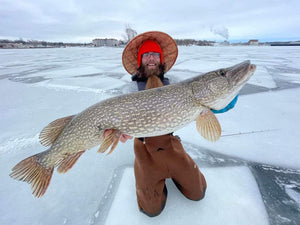The Catch:
Pike and Musky Mania
My 10 year old Nephew caught his first (and second) Musky recently. His Musky, also in the Pike (Esox) family, came while trolling spoons behind 30’ of 36lb Copper (Cu) line in the shallows of Lake St. Clair. Copper in Lake St. Clair you say? Yes. These waters are shallow and get fished so hard that half the challenge with catching the fish of a thousand casts is throwing something at it that it has never seen before.
This was early morning, but what’s fun about musky and pike is they’re active foragers all day. Water wolves cover such large areas the next challenge is finding where they’re hunting. Hint, find the schools of bait fish they’re feeding on and you’ll find the musky. For this reason, when we’re trolling +/-2.5mph we’ll often times set out walleye and smallmouth bass rigs on planer boards in conjunction with our musky, prop wash program.
The musky is the quintessential Apex predator. The only thing that will eat a musky is another musky. My nephew’s muskies measured 42.25” and 45.5” respectively. Both Master Anglers in their own right. Particularly interesting about this outing is they were both caught on the same 3.50” Custom Rift style spoon using 20lb monofilament backing and a 15lb fluorocarbon leader. Showing yet again, that you don’t need 100lb leaders and you definitely don’t need steel leaders (which have the tendency to tear and scar these catch and release beasts up) to land a nice fish (so long as you have a good rod and reel setup and your drag is set correctly). Besides, heavy leaders restrict lure action and can paralyze your fishing program. Period.

My first pike came when I was 7yrs old, casting Devil Dog spoons near the rocky banks in Manistee Lake. Although I was only brandishing a Zebco 404 meant for panfish, I wanted to try casting like my Dad. As the saying goes, persistence breaks down resistance and he soon rigged me up the old red & white standby. Casting came naturally and was so much fun that I was chucking and winding as fast as I could. It wasn’t long when a pike bounced its head off the side of our aluminum boat chasing my lure and I realized I should back the throttle down on the old spincast a touch. The very next cast, and no sooner did the lure hit the water and the reel started singing, peeling off line. To this day I have no idea how that line didn’t snap, how the rod didn’t break as it bent in half, or how we were able to net that fish.
We caught several more pike that day before it was time to head in after the largest fish of the day tore through the bottom of our old blue net and swam to freedom. Mine was a 36” monster. For this reason alone Dardevle and Zebco will always have a special place with me. The experts, the guys who are sponsored and paid to fish for a living will tell you that a push-button spincast reel is no way to learn how to fish and that a spinning reel or baitcaster reel are what kids should start off using instead.
Not that they’re wrong, not that that advice isn’t sound; but ‘catching fish every time I go fishing’ is also what I ‘should do’ too. Alas, we live in an imperfect world where bikes still have training wheels. What I say is anyway you start and learn how to fish is the best way. Just like anytime you’re not skunked and catch a fish is a good thing. If we sat around waiting for the perfect rod, the perfect reel, the perfect line, bait, boat, weather, and wind, we may never go fishing.
I don’t care if you’re jigging through the ice with a twenty four (24”) inch stick, pan fishing with a cane pole, surf fishing with a twelve (12’) foot noodle rod, or hand-lining with some wire and a wooden plank. Whatever experience it was that made you love Sportfishing is a good thing. Nay, it’s a great thing.
Happy fish and Tight lines. Welcome to the Evolution,
Article written by Mike (Fish Mitts) Hiller

Picture courtesy of Zach

